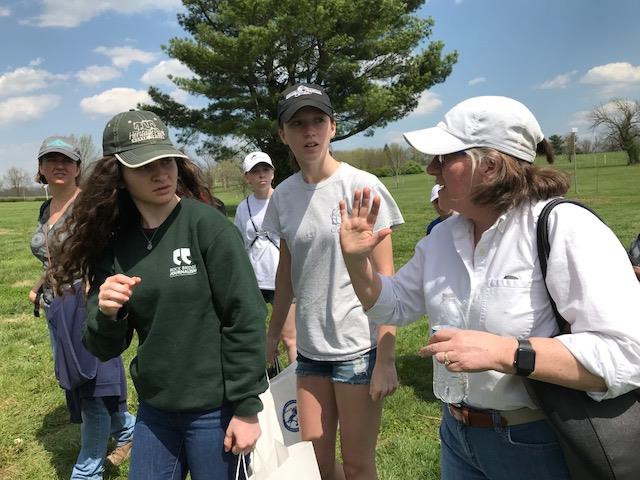Some Kentucky equestrians who also are involved in STEM—science, technology, engineering, and mathematics—are showing young horse-lovers how their passions for equestrian sport and STEM disciplines can lead to a career that combines both.
The effort started informally this year when Dr. James MacLeod, professor of veterinary science and the

John and Elizabeth Knight Chair at the University of Kentucky’s Gluck Equine Research Center in Lexington, Ky., was pondering how to entertain his horse-crazy niece and her barnmates on a visit to the Bluegrass for the Land Rover Kentucky Three-Day Event. Inspiration struck: why not include an educational opportunity to reveal some of the science behind both the competition and the raising of equine athletes?
“My niece, Kaya MacLeod, came the event last year as a spectator,” explained MacLeod, who grew up riding hunter/jumpers. “She’s a horse kid, and, of course, truly enjoyed the Horse Park and surrounding countryside. She went back home to Missouri with pictures and over-the-top enthusiasm, and the whole barn group decided to take a road trip and pilgrimage this year.
“I’m a geeky uncle who does biomedical research, but I was a horse kid myself and still enjoy riding,” MacLeod continued. “I try to get young horse people to think that loving horses and being interested in them can go beyond winning ribbons. You can even find ways to leverage your interests into a career.”
MacLeod and several of his colleagues at the University of Kentucky teamed up to give the visiting kids—all riders from grades 5-12 and a variety of equestrian disciplines at the Columbia Equestrian Center in Columbia, Mo.—a unique behind-the-scenes look at how science is working in the equine industry. The group visited Spy Coast Farm’s Kentucky division, located close to the Kentucky Horse Park, to learn more about their breeding and young horse training programs. At the Kentucky Horse Park, University of Kentucky mechanical engineering professor Dr. Suzanne Smith and mechanical engineering graduate student Shannon Wood, who also is a three-day eventer, met the group during the Kentucky Three-Day Event’s cross-country phase to discuss their work. Smith leads a research group, including Wood, that has been conducting a two-year study for the United States Eventing Association analyzing how horses jump. They’re collecting data that can inform continuing development of safety devices in fence design.

“Shannon came up with a citizen science survey, which people can still take online,” explained Smith, who is UK’s Donald and Gertrude Lester Professor of Mechanical Engineering and specializes in dynamics and motion. “You take about 10 measurements of your horse’s size and shape, and it’s easy to do with a soft measuring tape. You enter those into the survey, and that information goes into our data set, which really helps us.
“Students like Shannon are bringing their horse expertise and their knowledge of engineering to bear on this study,” said Smith. “It really takes both. Your life experience really makes a difference when you’re trying to work a complex problem like this. So if kids have an interest in STEM and they also love horses, there are all kinds of things that they could study in science and technology, in engineering and math, that will still allow them to work with horses while they’re doing it. And it doesn’t have to be a safety project like this; there are a lot of paths that will allow them to pursue both of those loves.”
MacLeod agrees, both for STEM careers and others.
“Other than owning or managing a farm, horse-affiliated career paths that people think about include equine veterinarian or farrier, but there are so many others,” he said. “All you have to do is look around in central Kentucky and you see all of the industries and professionals that derive a portion or even all of their income from the horse world. It can be science-based, business-based, or people-based—everything from equipment, to marketing, to writing, to law and contracts, to fashion and clothes, to farm supplies, to designing barns, to optimizing landscapes, and many others.”
Watching the young equestrians absorb some of the science behind horse sports, Kaya’s mom Meera

Sood said, “I want her to have an appreciation of the sport and the hard work that goes into it, but also the science. I’m a middle-school science teacher, so I love the STEM stuff that goes into building the jumps, and the math and the science that goes into it. Now that she’s in seventh grade, she’s starting to have a bigger awareness of it and the physics behind the jumping. At home, we’ve talked about how Newton’s laws can work with you or against you in your jumping, but for her to see it here at a professional level, it really sinks in.”
That’s something that veterinarian and university scientist MacLeod hopes will stay with the kids, helping them gain a deeper knowledge of equestrian sport and perhaps inspiring some to pursue studies that combine an interest for STEM subjects with their passion for horses.
“The ability of the kids to relate to somebody like Shannon is important,” MacLeod said. “She’s only a few years older than they are, and so they can listen to her and think, ‘This person was me just a little while ago, and now she’s doing this!’
“There are so many careers for somebody who loves horses. I think it’s neat that these young ladies from middle school and high school could be exposed to that and think about that. Maybe it will spark an interest to go farther.”


